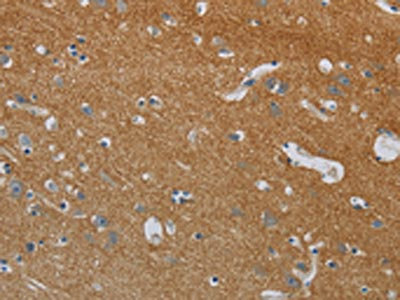
The image on the left is immunohistochemistry of paraffin-embedded Human brain tissue using CSB-PA780265(DPYSL3 Antibody) at dilution 1/20, on the right is treated with synthetic peptide. (Original magnification: x200)
DPYSL3 Antibody
CSB-PA780265
ApplicationsWestern Blot, ELISA, ImmunoHistoChemistry
Product group Antibodies
ReactivityHuman, Mouse, Rat
TargetDPYSL3
Overview
- SupplierCusabio
- Product NameDPYSL3 Antibody
- Delivery Days Customer20
- ApplicationsWestern Blot, ELISA, ImmunoHistoChemistry
- CertificationResearch Use Only
- ClonalityPolyclonal
- ConjugateUnconjugated
- Gene ID1809
- Target nameDPYSL3
- Target descriptiondihydropyrimidinase like 3
- Target synonymscollapsin response mediator protein 4 long; CRMP4; CRMP-4; dihydropyrimidinase-related protein 3; DRP3; DRP-3; LCRMP; testicular secretory protein Li 7; ULIP; ULIP-1; unc-33-like phosphoprotein 1
- HostRabbit
- IsotypeIgG
- Protein IDQ14195
- Protein NameDihydropyrimidinase-related protein 3
- Scientific DescriptionCollapsin response mediator proteins (CRMPs), including CRMP-1 (DRP-1), CRMP-2 (DRP-2 or TOAD64), CRMP-3 (DRP-4), CRMP-4 (DRP-3) and CRMP-5 (DRP-5), mediate signal transduction after exposure of neural cells to the axon guidance molecule semaphorin 3A (SEMA3A)/collapsin. CRMPs are present in the developing cerebral cortex and neocortical neurons and are responsive to SEMA3A. In the adult brain, the expression of CRMPs is dramatically downregulated. However, they remain expressed in structures that retain their capacity for differentiation and plasticity. Developing neurons in the adult hippocampus of mammals, known as the dentate gyrus, express CRMP-4. Rodent neocortical neurons express CRMP-4 in the perikaryon, in neurites and at growth cones.
- ReactivityHuman, Mouse, Rat
- Storage Instruction-20°C or -80°C
- UNSPSC12352203

